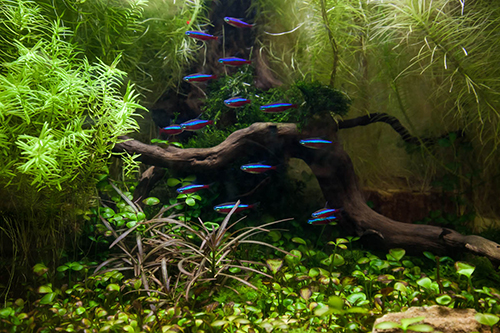Buying Your First Aquarium
Aug 29
Why You Shouldn’t Go Small
Perhaps the biggest question asked when one is shopping for their first aquarium is “what size should I get?” As with most topics in the hobby, there is no one size fits all answer to that question. But buying a small aquarium is arguably the worst decision you can make.
People often have the misconception that the larger the aquarium, the harder it’s going to be to keep, so they look for small “starter” aquariums. As a result, we’ve seen an explosion of all-in-one nano tanks being marketed as first aquariums. These tanks are often one to five gallons, contain most of what you need to get started, and claim to make for an easier learning experience.
The reality, though, is that in many cases larger aquariums are actually easier to keep and make for a better introduction to the aquarium hobby. Why is this? There are a few basic key benefits to larger tanks.
Dilution
There’s a somewhat cheesy saying in the hobby that the solution to pollution is dilution. The more water you have, the less concentrated other substances will be. Visualize it like this: think about adding a tablespoon of salt to water. If you add it to a shot glass, it probably won’t even fully dissolve. Add it to a cup and it’s going to be extremely salty. Add it to a bathtub and you probably wouldn’t notice. Add it to a lake and it will make virtually no difference whatsoever.
This same concept holds true for any potentially harmful substance in your aquarium, but it is especially important when looking at nitrogenous waste. You should be familiar with the Nitrogen Cycle if you’re looking for a new tank (if not, go look it up right now!), so you should know that any sort of biological waste (such as that being excreted by the fish or resulting from rotting food or dead plants) adds ammonia and ultimately nitrite and nitrate. Diluting these substances dramatically reduces the impact they have on your fish.
Stability
Stability is very closely related to dilution as being a fundamental advantage of having more water. Fish have evolved in bodies of water much larger than anything we can keep. Conditions in their natural habitats often don’t change much, and it takes time when they do. As a result, fish thrive when kept in stable water parameters. There are a number of different parameter we should consider, but two are perhaps most vital.
- Temperature - The more water you have, the more energy it takes to warm up (or the more energy has to be lost to cool down). In a small aquarium, you can have massive temperature fluctuations in a very short amount of time. This stresses your fish, leaving them vulnerable to a multitude of different infections to take hold.
- pH - Similarly, fish don’t tolerate swings in pH very well either. There are a few factors that affect the pH of an aquarium, but any specific water chemistry will be more stable in larger volumes. For example, most aquariums are going have a tendency for the pH to fall. This is because most fish waste is acidic (CO2 expelled by the fish reacts with water to form carbonic acid, nitrogenous waste can create nitric acid). Because larger volumes of water dilute these acids, the same amount of waste will have less affect in larger aquariums, leading to a more stable system
Selection
One of the biggest limitations that anybody with a small tank is going to face is simply not having many choices about what to keep. Most fish are simply going to be too large for small tanks. Many fish are best kept in groups which often are going to be too much for a small tank. Certain fish need a lot of swimming room which is impossible to have in small tanks.
All of this means that there is only a small number of potential fish to keep in your tank, and most people simply aren’t satisfied with their options. We all like variety, and aquariums are always more interesting when there are a number of different fish to watch. You just can’t have this in a small tank.
Small Tanks Aren’t Always Bad
All this is not to say that small tanks are impossible to keep well. We have seen a trend of hobbyists exploring nano tanks to try to carefully craft miniature worlds. There are stunning examples of tiny planted aquaria stocked with delicate shrimp and tiny fish. But this generally requires a certain amount of experience and knowledge to do well. Nano tanks require precise quality control and meticulous maintenance in order to succeed.
In contrast, a beginner should aim for a setup that gives some flexibility and forgiveness for mistakes, missed water changes, and a little trial and error.
How Big Is Too Big?
There does reach a point where going larger does start causing problems, though. If not planned properly, a 120 gallon aquarium has the potential to have cumbersome water changes. If you’re looking at tanks that are 200+ gallons, you probably want to start thinking about reinforcing floors to support the weight the tanks. Very large tanks can also get somewhat expensive to heat and run the filtration.
But the good news is that tanks this size are larger than even the average aquarist are going to be looking for. There are plenty of tank sizes that are easy to find that give you the advantages of large tanks without the disadvantages of giant ones.
The most popular tank size for many years has been the 55 gallon aquarium, most likely because it fits perfectly in this sweet spot. On its stand, a 55 gallon takes up a similar amount of space as a small bookcase. A 75 gallon is arguably an even better choice as it gives you more options while only taking up an extra six inches front to back over a55. These are large both enough to be stable, are easy to find, can be placed practically anywhere, and open up a wide range of stocking options.
So what size tank should you look for? The answer is going to be different based on your circumstances, but I never recommended less than 10 gallons when working retail. The best answer I can give you is to choose the largest aquarium that your space and budget will allow.












